Jack Welch's Transformational Leadership: A Catalyst for Change at GE
VerifiedAdded on 2019/10/31
|10
|2853
|165
Report
AI Summary
The content discusses Jack Welch's leadership style and its impact on General Electric (GE) during his tenure as CEO from 1981 to 2001. Welch introduced a flat organizational structure, promoted empowerment of employees, and focused on customer satisfaction. He believed in being the number one or two player in each industry, which led to significant changes within GE's business lines. This approach resulted in a leaner workforce and increased productivity. Welch's leadership style was characterized by his ability to create an open environment where employees felt comfortable sharing their concerns and suggestions. He also promoted shared decision-making through the 7S model and empowered employees to take ownership of their work.
Contribute Materials
Your contribution can guide someone’s learning journey. Share your
documents today.
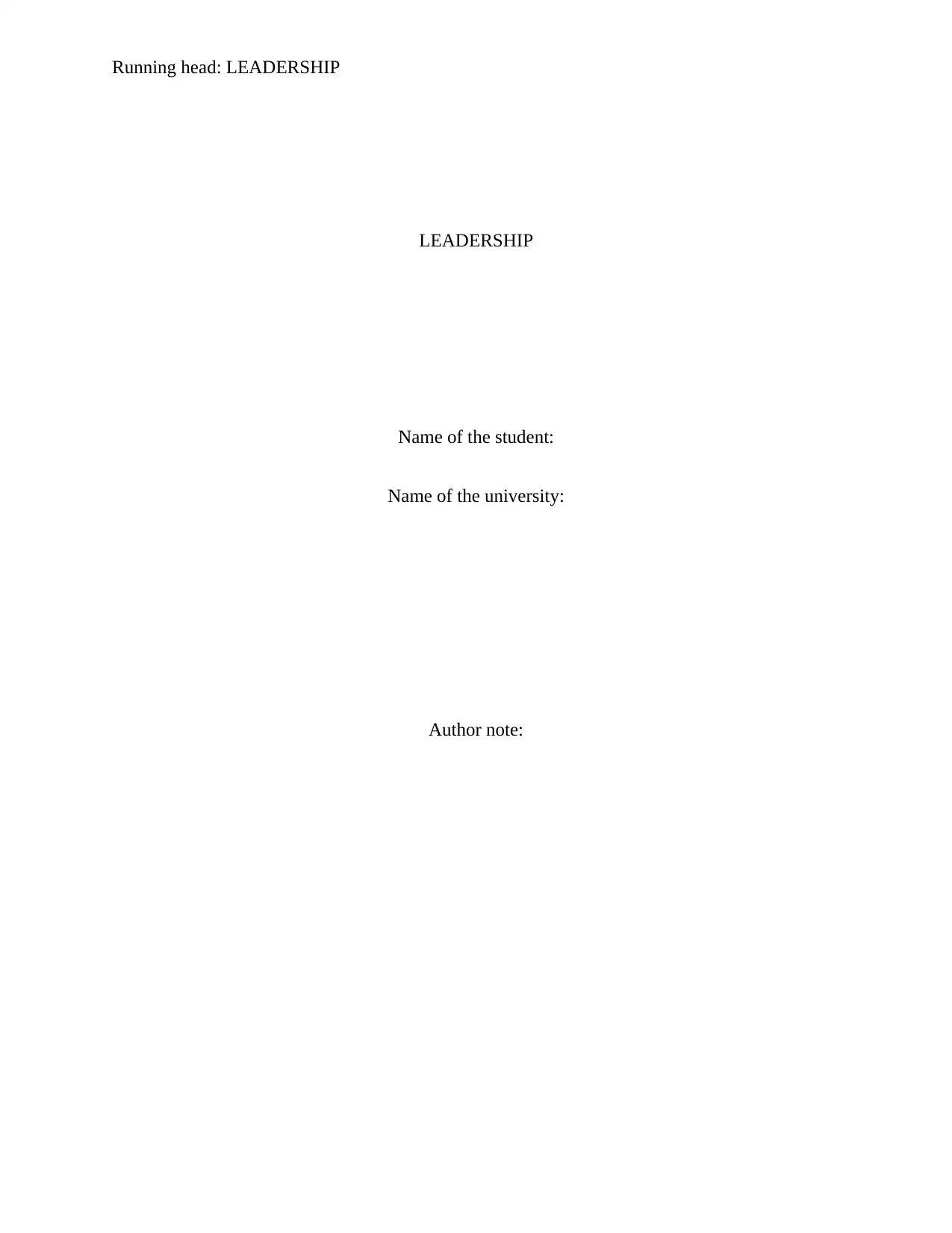
Running head: LEADERSHIP
LEADERSHIP
Name of the student:
Name of the university:
Author note:
LEADERSHIP
Name of the student:
Name of the university:
Author note:
Secure Best Marks with AI Grader
Need help grading? Try our AI Grader for instant feedback on your assignments.
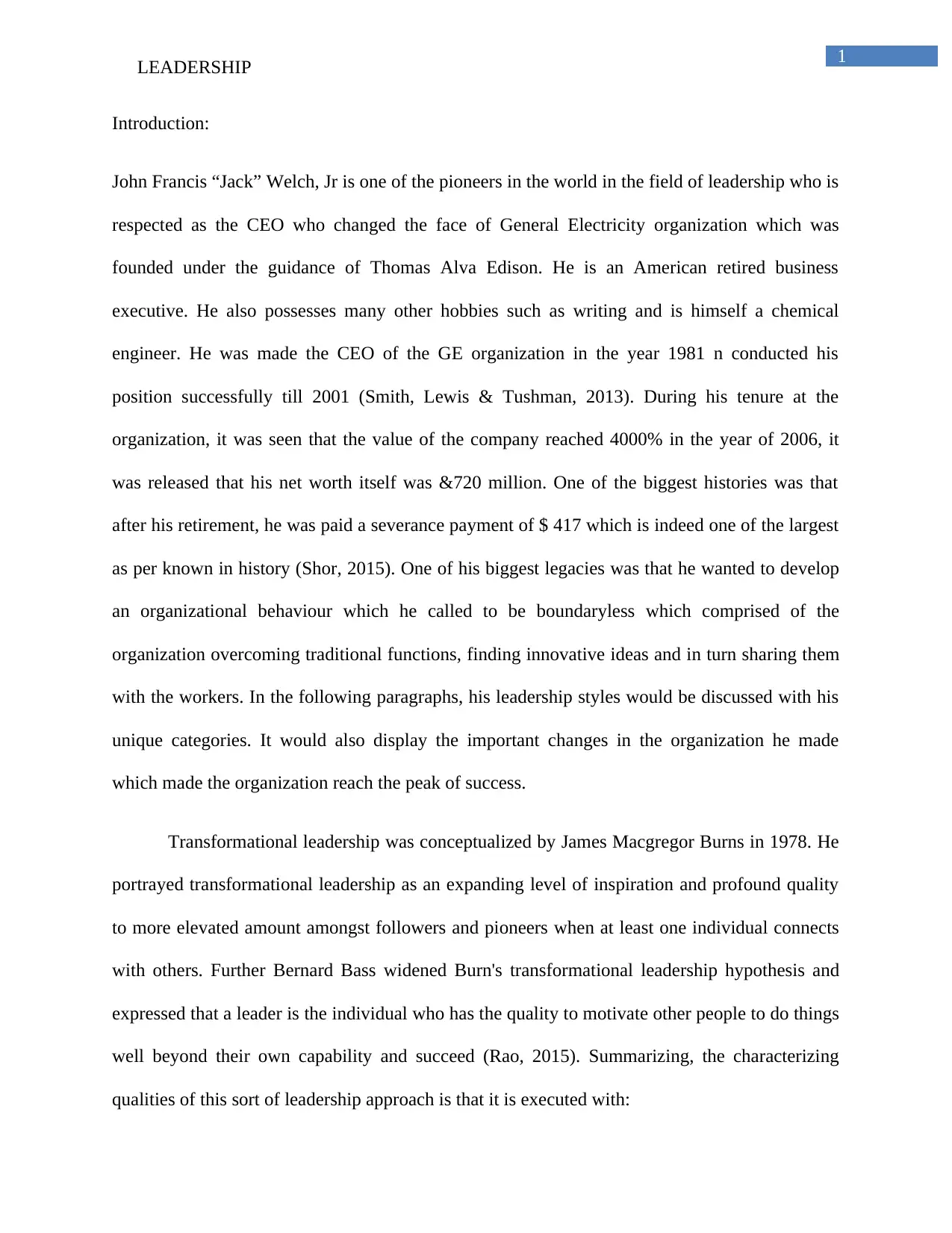
1
LEADERSHIP
Introduction:
John Francis “Jack” Welch, Jr is one of the pioneers in the world in the field of leadership who is
respected as the CEO who changed the face of General Electricity organization which was
founded under the guidance of Thomas Alva Edison. He is an American retired business
executive. He also possesses many other hobbies such as writing and is himself a chemical
engineer. He was made the CEO of the GE organization in the year 1981 n conducted his
position successfully till 2001 (Smith, Lewis & Tushman, 2013). During his tenure at the
organization, it was seen that the value of the company reached 4000% in the year of 2006, it
was released that his net worth itself was &720 million. One of the biggest histories was that
after his retirement, he was paid a severance payment of $ 417 which is indeed one of the largest
as per known in history (Shor, 2015). One of his biggest legacies was that he wanted to develop
an organizational behaviour which he called to be boundaryless which comprised of the
organization overcoming traditional functions, finding innovative ideas and in turn sharing them
with the workers. In the following paragraphs, his leadership styles would be discussed with his
unique categories. It would also display the important changes in the organization he made
which made the organization reach the peak of success.
Transformational leadership was conceptualized by James Macgregor Burns in 1978. He
portrayed transformational leadership as an expanding level of inspiration and profound quality
to more elevated amount amongst followers and pioneers when at least one individual connects
with others. Further Bernard Bass widened Burn's transformational leadership hypothesis and
expressed that a leader is the individual who has the quality to motivate other people to do things
well beyond their own capability and succeed (Rao, 2015). Summarizing, the characterizing
qualities of this sort of leadership approach is that it is executed with:
LEADERSHIP
Introduction:
John Francis “Jack” Welch, Jr is one of the pioneers in the world in the field of leadership who is
respected as the CEO who changed the face of General Electricity organization which was
founded under the guidance of Thomas Alva Edison. He is an American retired business
executive. He also possesses many other hobbies such as writing and is himself a chemical
engineer. He was made the CEO of the GE organization in the year 1981 n conducted his
position successfully till 2001 (Smith, Lewis & Tushman, 2013). During his tenure at the
organization, it was seen that the value of the company reached 4000% in the year of 2006, it
was released that his net worth itself was &720 million. One of the biggest histories was that
after his retirement, he was paid a severance payment of $ 417 which is indeed one of the largest
as per known in history (Shor, 2015). One of his biggest legacies was that he wanted to develop
an organizational behaviour which he called to be boundaryless which comprised of the
organization overcoming traditional functions, finding innovative ideas and in turn sharing them
with the workers. In the following paragraphs, his leadership styles would be discussed with his
unique categories. It would also display the important changes in the organization he made
which made the organization reach the peak of success.
Transformational leadership was conceptualized by James Macgregor Burns in 1978. He
portrayed transformational leadership as an expanding level of inspiration and profound quality
to more elevated amount amongst followers and pioneers when at least one individual connects
with others. Further Bernard Bass widened Burn's transformational leadership hypothesis and
expressed that a leader is the individual who has the quality to motivate other people to do things
well beyond their own capability and succeed (Rao, 2015). Summarizing, the characterizing
qualities of this sort of leadership approach is that it is executed with:
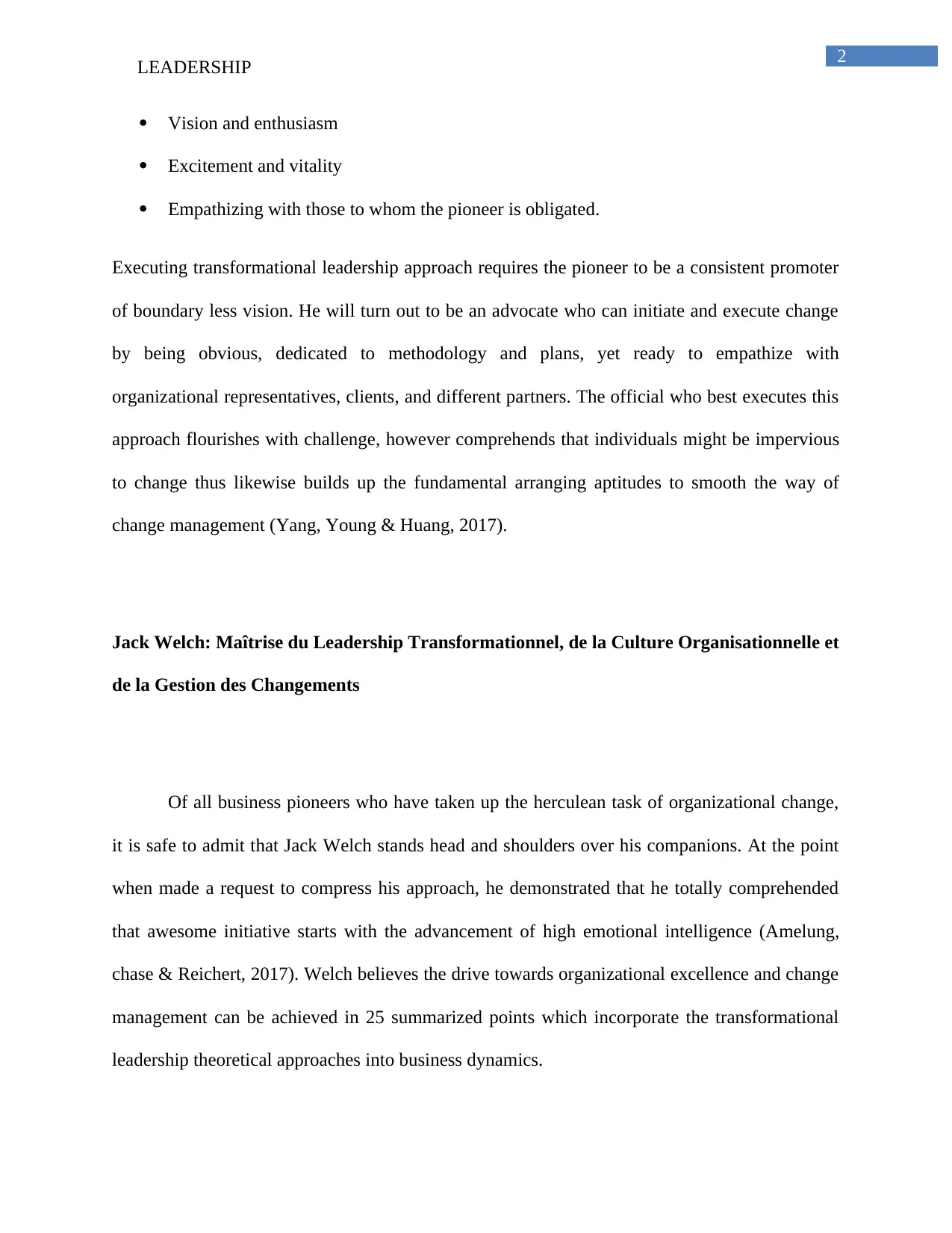
2
LEADERSHIP
Vision and enthusiasm
Excitement and vitality
Empathizing with those to whom the pioneer is obligated.
Executing transformational leadership approach requires the pioneer to be a consistent promoter
of boundary less vision. He will turn out to be an advocate who can initiate and execute change
by being obvious, dedicated to methodology and plans, yet ready to empathize with
organizational representatives, clients, and different partners. The official who best executes this
approach flourishes with challenge, however comprehends that individuals might be impervious
to change thus likewise builds up the fundamental arranging aptitudes to smooth the way of
change management (Yang, Young & Huang, 2017).
Jack Welch: Maîtrise du Leadership Transformationnel, de la Culture Organisationnelle et
de la Gestion des Changements
Of all business pioneers who have taken up the herculean task of organizational change,
it is safe to admit that Jack Welch stands head and shoulders over his companions. At the point
when made a request to compress his approach, he demonstrated that he totally comprehended
that awesome initiative starts with the advancement of high emotional intelligence (Amelung,
chase & Reichert, 2017). Welch believes the drive towards organizational excellence and change
management can be achieved in 25 summarized points which incorporate the transformational
leadership theoretical approaches into business dynamics.
LEADERSHIP
Vision and enthusiasm
Excitement and vitality
Empathizing with those to whom the pioneer is obligated.
Executing transformational leadership approach requires the pioneer to be a consistent promoter
of boundary less vision. He will turn out to be an advocate who can initiate and execute change
by being obvious, dedicated to methodology and plans, yet ready to empathize with
organizational representatives, clients, and different partners. The official who best executes this
approach flourishes with challenge, however comprehends that individuals might be impervious
to change thus likewise builds up the fundamental arranging aptitudes to smooth the way of
change management (Yang, Young & Huang, 2017).
Jack Welch: Maîtrise du Leadership Transformationnel, de la Culture Organisationnelle et
de la Gestion des Changements
Of all business pioneers who have taken up the herculean task of organizational change,
it is safe to admit that Jack Welch stands head and shoulders over his companions. At the point
when made a request to compress his approach, he demonstrated that he totally comprehended
that awesome initiative starts with the advancement of high emotional intelligence (Amelung,
chase & Reichert, 2017). Welch believes the drive towards organizational excellence and change
management can be achieved in 25 summarized points which incorporate the transformational
leadership theoretical approaches into business dynamics.
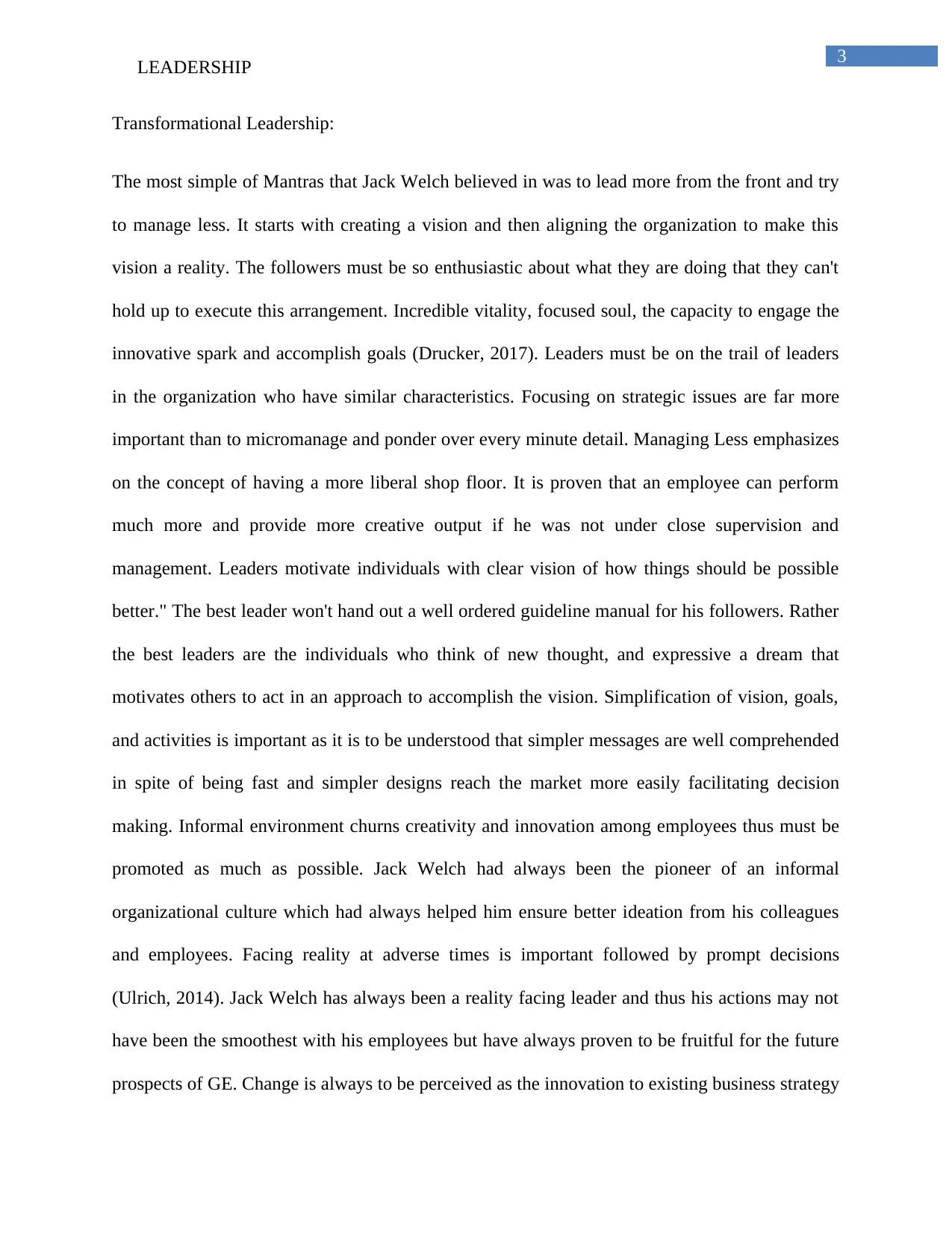
3
LEADERSHIP
Transformational Leadership:
The most simple of Mantras that Jack Welch believed in was to lead more from the front and try
to manage less. It starts with creating a vision and then aligning the organization to make this
vision a reality. The followers must be so enthusiastic about what they are doing that they can't
hold up to execute this arrangement. Incredible vitality, focused soul, the capacity to engage the
innovative spark and accomplish goals (Drucker, 2017). Leaders must be on the trail of leaders
in the organization who have similar characteristics. Focusing on strategic issues are far more
important than to micromanage and ponder over every minute detail. Managing Less emphasizes
on the concept of having a more liberal shop floor. It is proven that an employee can perform
much more and provide more creative output if he was not under close supervision and
management. Leaders motivate individuals with clear vision of how things should be possible
better." The best leader won't hand out a well ordered guideline manual for his followers. Rather
the best leaders are the individuals who think of new thought, and expressive a dream that
motivates others to act in an approach to accomplish the vision. Simplification of vision, goals,
and activities is important as it is to be understood that simpler messages are well comprehended
in spite of being fast and simpler designs reach the market more easily facilitating decision
making. Informal environment churns creativity and innovation among employees thus must be
promoted as much as possible. Jack Welch had always been the pioneer of an informal
organizational culture which had always helped him ensure better ideation from his colleagues
and employees. Facing reality at adverse times is important followed by prompt decisions
(Ulrich, 2014). Jack Welch has always been a reality facing leader and thus his actions may not
have been the smoothest with his employees but have always proven to be fruitful for the future
prospects of GE. Change is always to be perceived as the innovation to existing business strategy
LEADERSHIP
Transformational Leadership:
The most simple of Mantras that Jack Welch believed in was to lead more from the front and try
to manage less. It starts with creating a vision and then aligning the organization to make this
vision a reality. The followers must be so enthusiastic about what they are doing that they can't
hold up to execute this arrangement. Incredible vitality, focused soul, the capacity to engage the
innovative spark and accomplish goals (Drucker, 2017). Leaders must be on the trail of leaders
in the organization who have similar characteristics. Focusing on strategic issues are far more
important than to micromanage and ponder over every minute detail. Managing Less emphasizes
on the concept of having a more liberal shop floor. It is proven that an employee can perform
much more and provide more creative output if he was not under close supervision and
management. Leaders motivate individuals with clear vision of how things should be possible
better." The best leader won't hand out a well ordered guideline manual for his followers. Rather
the best leaders are the individuals who think of new thought, and expressive a dream that
motivates others to act in an approach to accomplish the vision. Simplification of vision, goals,
and activities is important as it is to be understood that simpler messages are well comprehended
in spite of being fast and simpler designs reach the market more easily facilitating decision
making. Informal environment churns creativity and innovation among employees thus must be
promoted as much as possible. Jack Welch had always been the pioneer of an informal
organizational culture which had always helped him ensure better ideation from his colleagues
and employees. Facing reality at adverse times is important followed by prompt decisions
(Ulrich, 2014). Jack Welch has always been a reality facing leader and thus his actions may not
have been the smoothest with his employees but have always proven to be fruitful for the future
prospects of GE. Change is always to be perceived as the innovation to existing business strategy
Secure Best Marks with AI Grader
Need help grading? Try our AI Grader for instant feedback on your assignments.
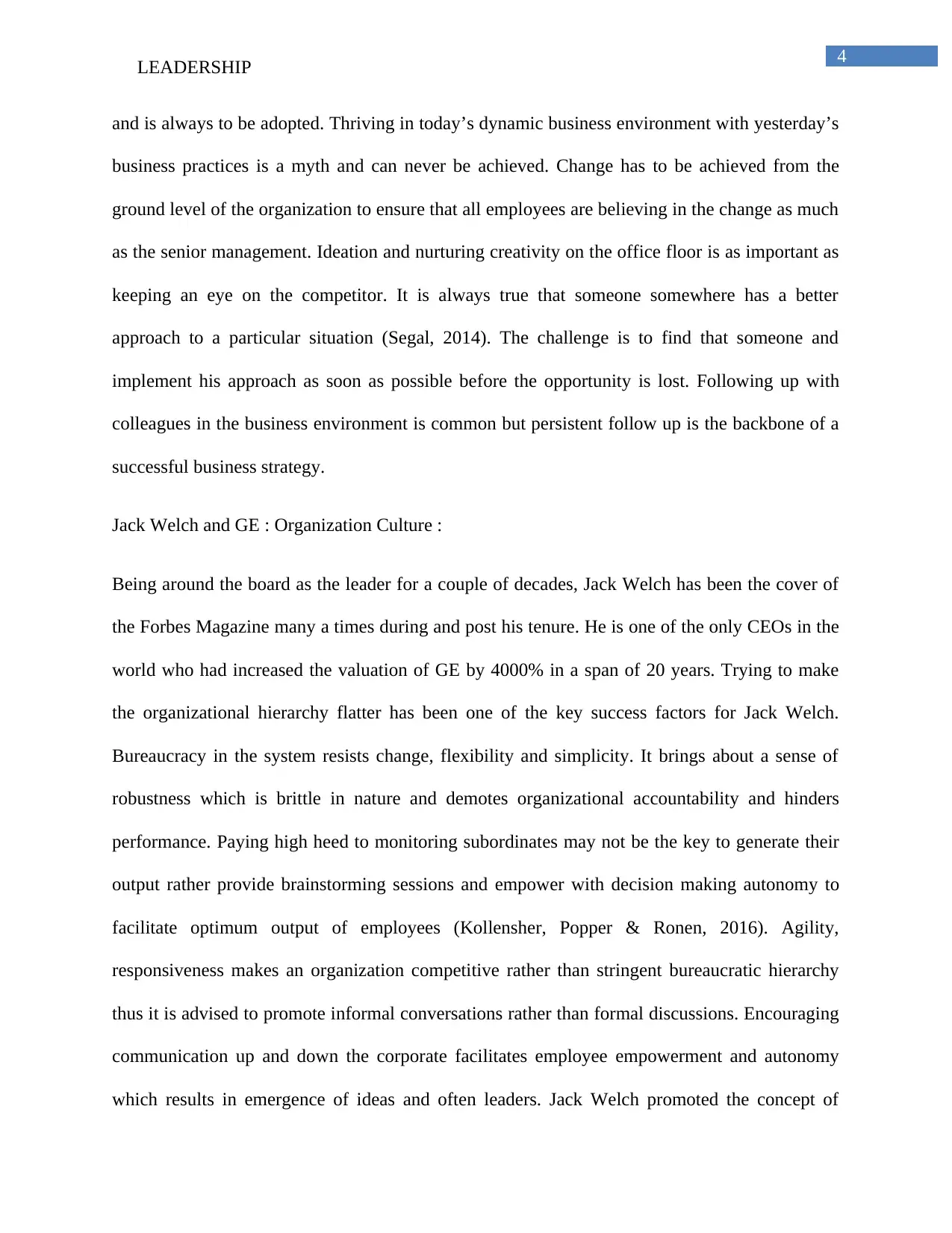
4
LEADERSHIP
and is always to be adopted. Thriving in today’s dynamic business environment with yesterday’s
business practices is a myth and can never be achieved. Change has to be achieved from the
ground level of the organization to ensure that all employees are believing in the change as much
as the senior management. Ideation and nurturing creativity on the office floor is as important as
keeping an eye on the competitor. It is always true that someone somewhere has a better
approach to a particular situation (Segal, 2014). The challenge is to find that someone and
implement his approach as soon as possible before the opportunity is lost. Following up with
colleagues in the business environment is common but persistent follow up is the backbone of a
successful business strategy.
Jack Welch and GE : Organization Culture :
Being around the board as the leader for a couple of decades, Jack Welch has been the cover of
the Forbes Magazine many a times during and post his tenure. He is one of the only CEOs in the
world who had increased the valuation of GE by 4000% in a span of 20 years. Trying to make
the organizational hierarchy flatter has been one of the key success factors for Jack Welch.
Bureaucracy in the system resists change, flexibility and simplicity. It brings about a sense of
robustness which is brittle in nature and demotes organizational accountability and hinders
performance. Paying high heed to monitoring subordinates may not be the key to generate their
output rather provide brainstorming sessions and empower with decision making autonomy to
facilitate optimum output of employees (Kollensher, Popper & Ronen, 2016). Agility,
responsiveness makes an organization competitive rather than stringent bureaucratic hierarchy
thus it is advised to promote informal conversations rather than formal discussions. Encouraging
communication up and down the corporate facilitates employee empowerment and autonomy
which results in emergence of ideas and often leaders. Jack Welch promoted the concept of
LEADERSHIP
and is always to be adopted. Thriving in today’s dynamic business environment with yesterday’s
business practices is a myth and can never be achieved. Change has to be achieved from the
ground level of the organization to ensure that all employees are believing in the change as much
as the senior management. Ideation and nurturing creativity on the office floor is as important as
keeping an eye on the competitor. It is always true that someone somewhere has a better
approach to a particular situation (Segal, 2014). The challenge is to find that someone and
implement his approach as soon as possible before the opportunity is lost. Following up with
colleagues in the business environment is common but persistent follow up is the backbone of a
successful business strategy.
Jack Welch and GE : Organization Culture :
Being around the board as the leader for a couple of decades, Jack Welch has been the cover of
the Forbes Magazine many a times during and post his tenure. He is one of the only CEOs in the
world who had increased the valuation of GE by 4000% in a span of 20 years. Trying to make
the organizational hierarchy flatter has been one of the key success factors for Jack Welch.
Bureaucracy in the system resists change, flexibility and simplicity. It brings about a sense of
robustness which is brittle in nature and demotes organizational accountability and hinders
performance. Paying high heed to monitoring subordinates may not be the key to generate their
output rather provide brainstorming sessions and empower with decision making autonomy to
facilitate optimum output of employees (Kollensher, Popper & Ronen, 2016). Agility,
responsiveness makes an organization competitive rather than stringent bureaucratic hierarchy
thus it is advised to promote informal conversations rather than formal discussions. Encouraging
communication up and down the corporate facilitates employee empowerment and autonomy
which results in emergence of ideas and often leaders. Jack Welch promoted the concept of
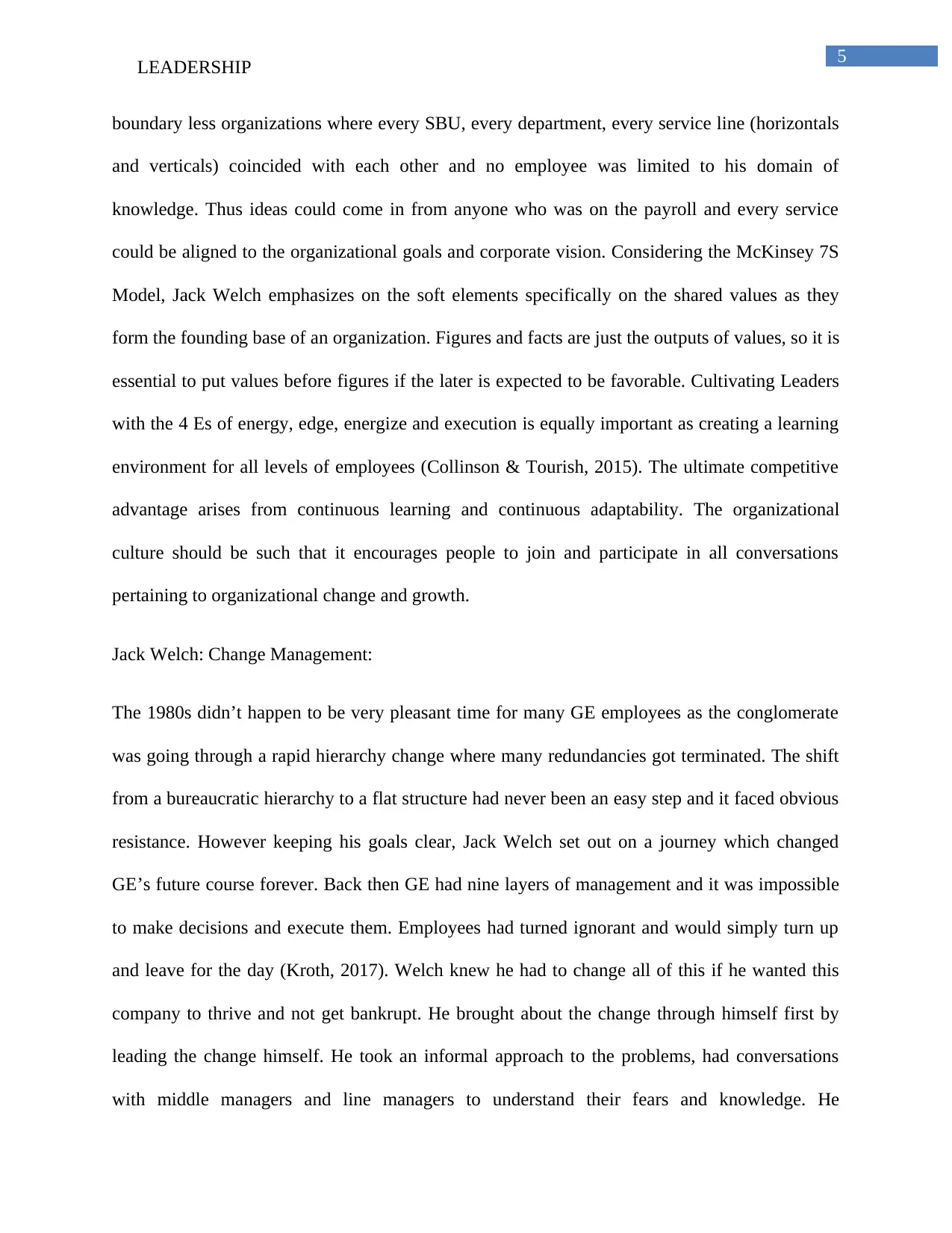
5
LEADERSHIP
boundary less organizations where every SBU, every department, every service line (horizontals
and verticals) coincided with each other and no employee was limited to his domain of
knowledge. Thus ideas could come in from anyone who was on the payroll and every service
could be aligned to the organizational goals and corporate vision. Considering the McKinsey 7S
Model, Jack Welch emphasizes on the soft elements specifically on the shared values as they
form the founding base of an organization. Figures and facts are just the outputs of values, so it is
essential to put values before figures if the later is expected to be favorable. Cultivating Leaders
with the 4 Es of energy, edge, energize and execution is equally important as creating a learning
environment for all levels of employees (Collinson & Tourish, 2015). The ultimate competitive
advantage arises from continuous learning and continuous adaptability. The organizational
culture should be such that it encourages people to join and participate in all conversations
pertaining to organizational change and growth.
Jack Welch: Change Management:
The 1980s didn’t happen to be very pleasant time for many GE employees as the conglomerate
was going through a rapid hierarchy change where many redundancies got terminated. The shift
from a bureaucratic hierarchy to a flat structure had never been an easy step and it faced obvious
resistance. However keeping his goals clear, Jack Welch set out on a journey which changed
GE’s future course forever. Back then GE had nine layers of management and it was impossible
to make decisions and execute them. Employees had turned ignorant and would simply turn up
and leave for the day (Kroth, 2017). Welch knew he had to change all of this if he wanted this
company to thrive and not get bankrupt. He brought about the change through himself first by
leading the change himself. He took an informal approach to the problems, had conversations
with middle managers and line managers to understand their fears and knowledge. He
LEADERSHIP
boundary less organizations where every SBU, every department, every service line (horizontals
and verticals) coincided with each other and no employee was limited to his domain of
knowledge. Thus ideas could come in from anyone who was on the payroll and every service
could be aligned to the organizational goals and corporate vision. Considering the McKinsey 7S
Model, Jack Welch emphasizes on the soft elements specifically on the shared values as they
form the founding base of an organization. Figures and facts are just the outputs of values, so it is
essential to put values before figures if the later is expected to be favorable. Cultivating Leaders
with the 4 Es of energy, edge, energize and execution is equally important as creating a learning
environment for all levels of employees (Collinson & Tourish, 2015). The ultimate competitive
advantage arises from continuous learning and continuous adaptability. The organizational
culture should be such that it encourages people to join and participate in all conversations
pertaining to organizational change and growth.
Jack Welch: Change Management:
The 1980s didn’t happen to be very pleasant time for many GE employees as the conglomerate
was going through a rapid hierarchy change where many redundancies got terminated. The shift
from a bureaucratic hierarchy to a flat structure had never been an easy step and it faced obvious
resistance. However keeping his goals clear, Jack Welch set out on a journey which changed
GE’s future course forever. Back then GE had nine layers of management and it was impossible
to make decisions and execute them. Employees had turned ignorant and would simply turn up
and leave for the day (Kroth, 2017). Welch knew he had to change all of this if he wanted this
company to thrive and not get bankrupt. He brought about the change through himself first by
leading the change himself. He took an informal approach to the problems, had conversations
with middle managers and line managers to understand their fears and knowledge. He
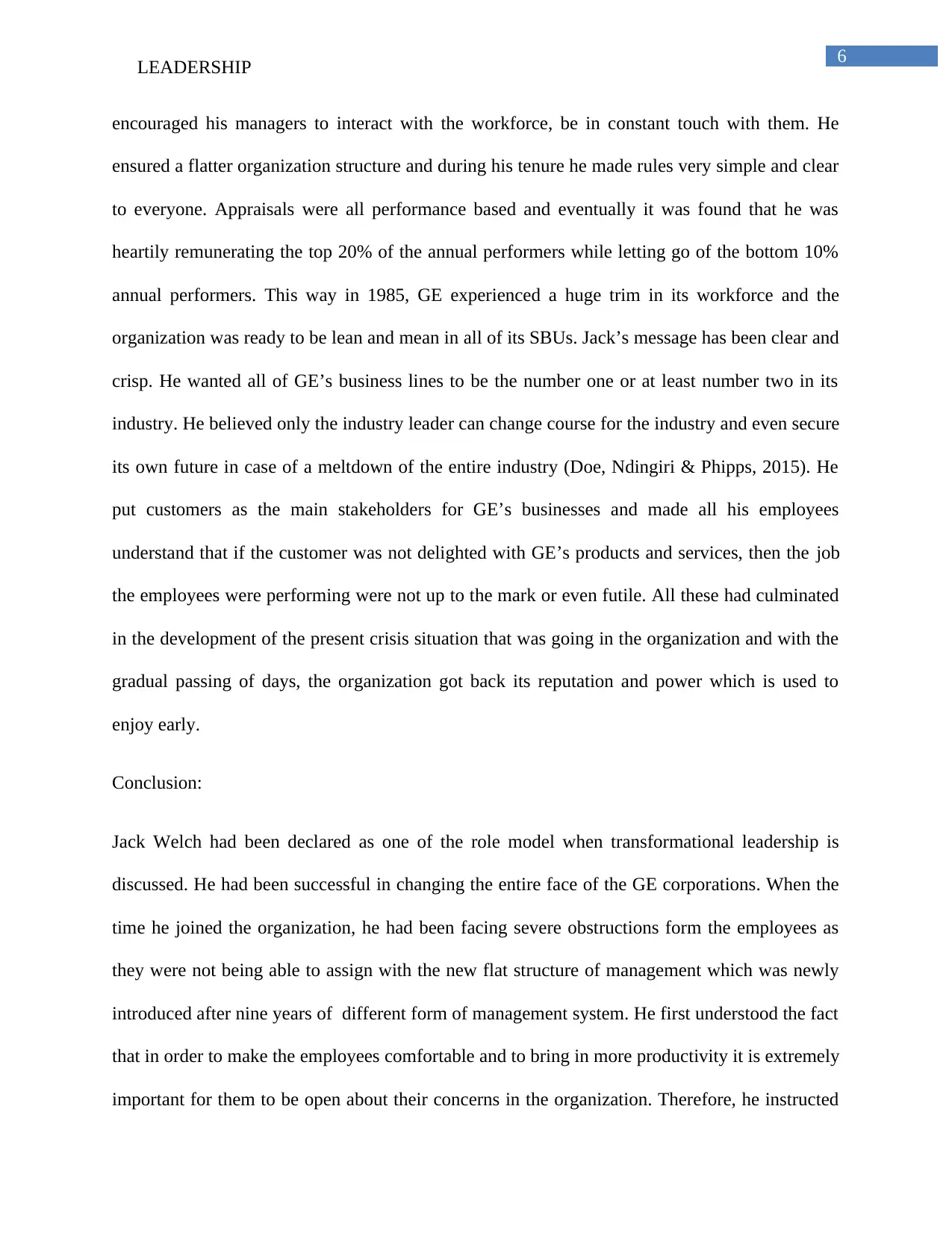
6
LEADERSHIP
encouraged his managers to interact with the workforce, be in constant touch with them. He
ensured a flatter organization structure and during his tenure he made rules very simple and clear
to everyone. Appraisals were all performance based and eventually it was found that he was
heartily remunerating the top 20% of the annual performers while letting go of the bottom 10%
annual performers. This way in 1985, GE experienced a huge trim in its workforce and the
organization was ready to be lean and mean in all of its SBUs. Jack’s message has been clear and
crisp. He wanted all of GE’s business lines to be the number one or at least number two in its
industry. He believed only the industry leader can change course for the industry and even secure
its own future in case of a meltdown of the entire industry (Doe, Ndingiri & Phipps, 2015). He
put customers as the main stakeholders for GE’s businesses and made all his employees
understand that if the customer was not delighted with GE’s products and services, then the job
the employees were performing were not up to the mark or even futile. All these had culminated
in the development of the present crisis situation that was going in the organization and with the
gradual passing of days, the organization got back its reputation and power which is used to
enjoy early.
Conclusion:
Jack Welch had been declared as one of the role model when transformational leadership is
discussed. He had been successful in changing the entire face of the GE corporations. When the
time he joined the organization, he had been facing severe obstructions form the employees as
they were not being able to assign with the new flat structure of management which was newly
introduced after nine years of different form of management system. He first understood the fact
that in order to make the employees comfortable and to bring in more productivity it is extremely
important for them to be open about their concerns in the organization. Therefore, he instructed
LEADERSHIP
encouraged his managers to interact with the workforce, be in constant touch with them. He
ensured a flatter organization structure and during his tenure he made rules very simple and clear
to everyone. Appraisals were all performance based and eventually it was found that he was
heartily remunerating the top 20% of the annual performers while letting go of the bottom 10%
annual performers. This way in 1985, GE experienced a huge trim in its workforce and the
organization was ready to be lean and mean in all of its SBUs. Jack’s message has been clear and
crisp. He wanted all of GE’s business lines to be the number one or at least number two in its
industry. He believed only the industry leader can change course for the industry and even secure
its own future in case of a meltdown of the entire industry (Doe, Ndingiri & Phipps, 2015). He
put customers as the main stakeholders for GE’s businesses and made all his employees
understand that if the customer was not delighted with GE’s products and services, then the job
the employees were performing were not up to the mark or even futile. All these had culminated
in the development of the present crisis situation that was going in the organization and with the
gradual passing of days, the organization got back its reputation and power which is used to
enjoy early.
Conclusion:
Jack Welch had been declared as one of the role model when transformational leadership is
discussed. He had been successful in changing the entire face of the GE corporations. When the
time he joined the organization, he had been facing severe obstructions form the employees as
they were not being able to assign with the new flat structure of management which was newly
introduced after nine years of different form of management system. He first understood the fact
that in order to make the employees comfortable and to bring in more productivity it is extremely
important for them to be open about their concerns in the organization. Therefore, he instructed
Paraphrase This Document
Need a fresh take? Get an instant paraphrase of this document with our AI Paraphraser
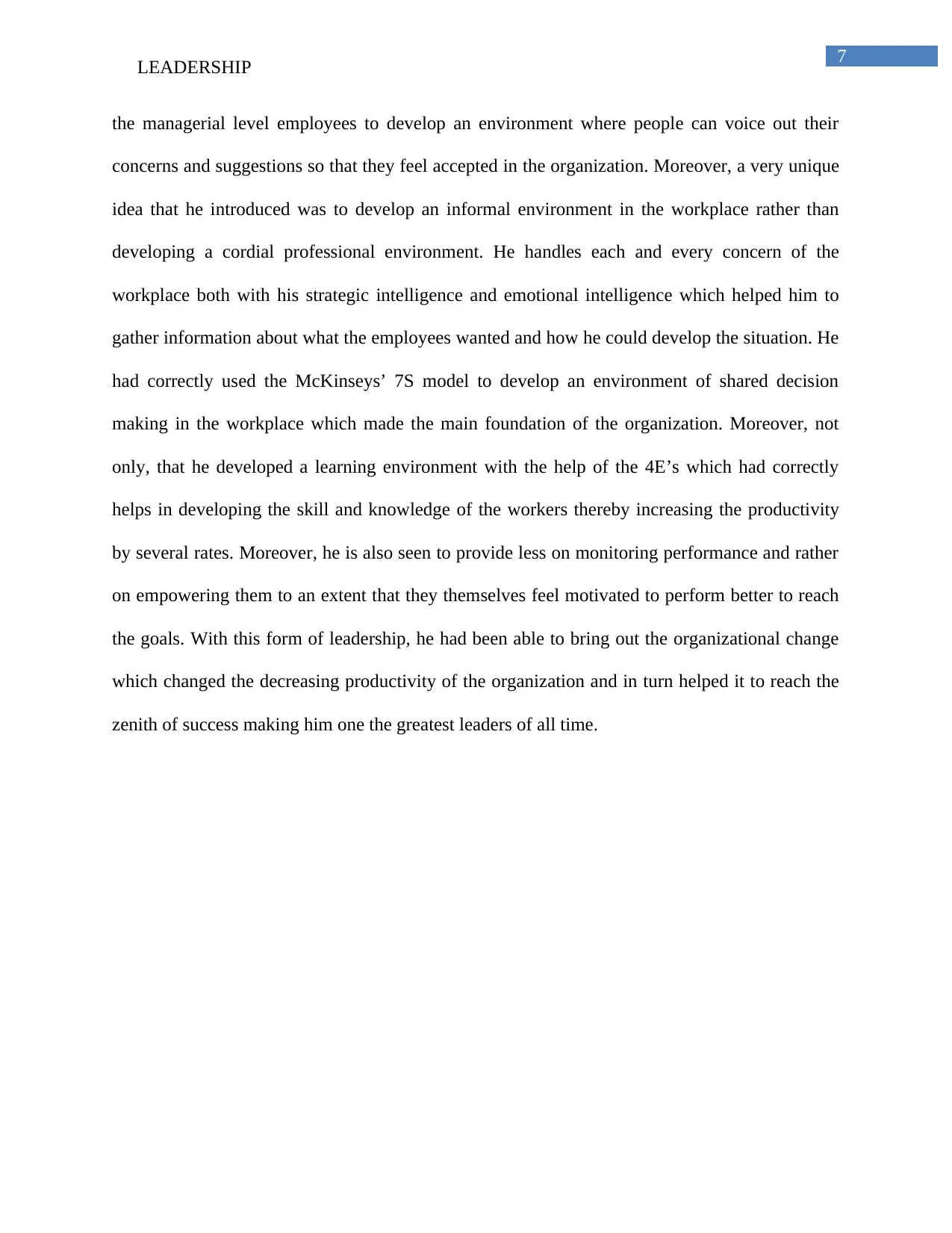
7
LEADERSHIP
the managerial level employees to develop an environment where people can voice out their
concerns and suggestions so that they feel accepted in the organization. Moreover, a very unique
idea that he introduced was to develop an informal environment in the workplace rather than
developing a cordial professional environment. He handles each and every concern of the
workplace both with his strategic intelligence and emotional intelligence which helped him to
gather information about what the employees wanted and how he could develop the situation. He
had correctly used the McKinseys’ 7S model to develop an environment of shared decision
making in the workplace which made the main foundation of the organization. Moreover, not
only, that he developed a learning environment with the help of the 4E’s which had correctly
helps in developing the skill and knowledge of the workers thereby increasing the productivity
by several rates. Moreover, he is also seen to provide less on monitoring performance and rather
on empowering them to an extent that they themselves feel motivated to perform better to reach
the goals. With this form of leadership, he had been able to bring out the organizational change
which changed the decreasing productivity of the organization and in turn helped it to reach the
zenith of success making him one the greatest leaders of all time.
LEADERSHIP
the managerial level employees to develop an environment where people can voice out their
concerns and suggestions so that they feel accepted in the organization. Moreover, a very unique
idea that he introduced was to develop an informal environment in the workplace rather than
developing a cordial professional environment. He handles each and every concern of the
workplace both with his strategic intelligence and emotional intelligence which helped him to
gather information about what the employees wanted and how he could develop the situation. He
had correctly used the McKinseys’ 7S model to develop an environment of shared decision
making in the workplace which made the main foundation of the organization. Moreover, not
only, that he developed a learning environment with the help of the 4E’s which had correctly
helps in developing the skill and knowledge of the workers thereby increasing the productivity
by several rates. Moreover, he is also seen to provide less on monitoring performance and rather
on empowering them to an extent that they themselves feel motivated to perform better to reach
the goals. With this form of leadership, he had been able to bring out the organizational change
which changed the decreasing productivity of the organization and in turn helped it to reach the
zenith of success making him one the greatest leaders of all time.
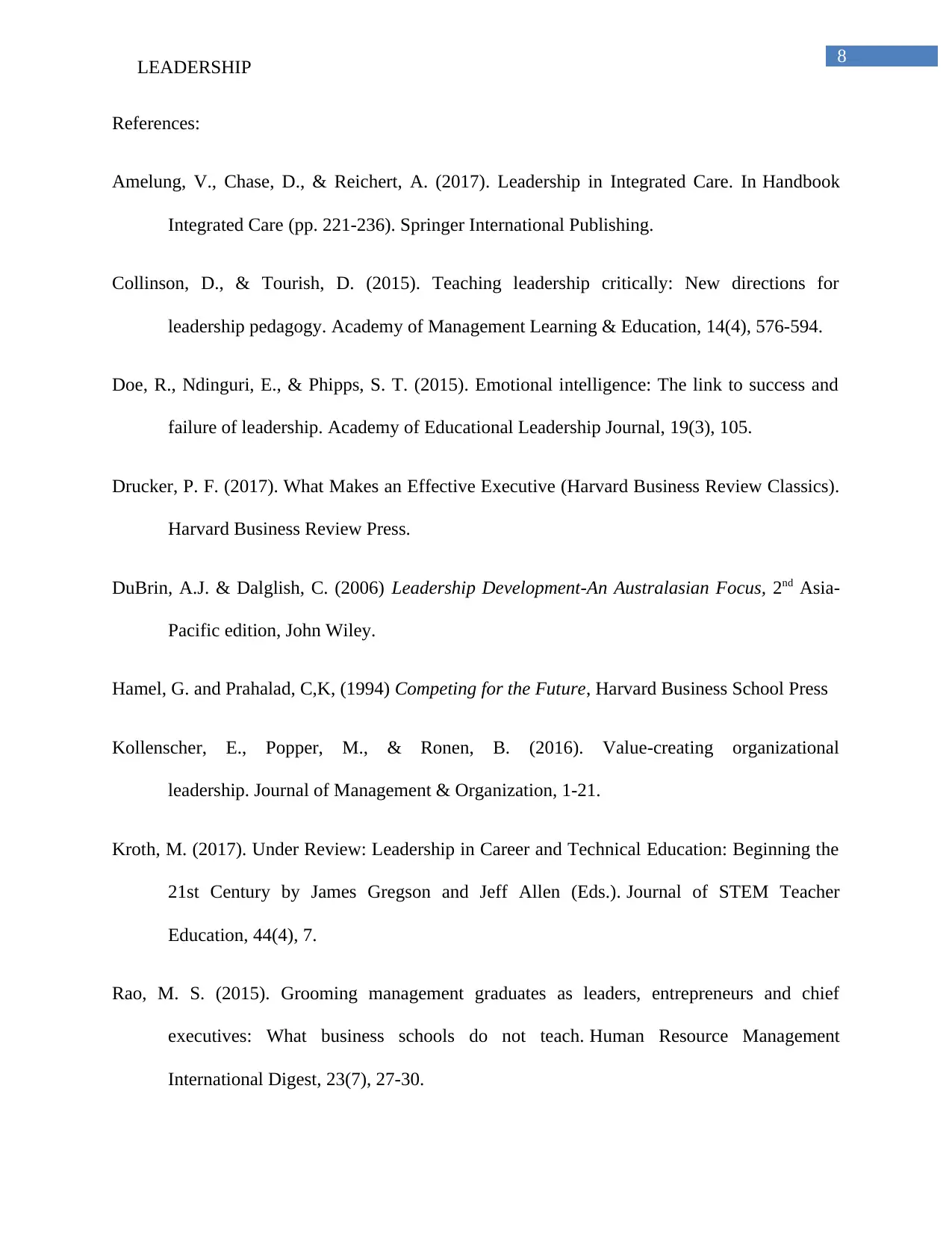
8
LEADERSHIP
References:
Amelung, V., Chase, D., & Reichert, A. (2017). Leadership in Integrated Care. In Handbook
Integrated Care (pp. 221-236). Springer International Publishing.
Collinson, D., & Tourish, D. (2015). Teaching leadership critically: New directions for
leadership pedagogy. Academy of Management Learning & Education, 14(4), 576-594.
Doe, R., Ndinguri, E., & Phipps, S. T. (2015). Emotional intelligence: The link to success and
failure of leadership. Academy of Educational Leadership Journal, 19(3), 105.
Drucker, P. F. (2017). What Makes an Effective Executive (Harvard Business Review Classics).
Harvard Business Review Press.
DuBrin, A.J. & Dalglish, C. (2006) Leadership Development-An Australasian Focus, 2nd Asia-
Pacific edition, John Wiley.
Hamel, G. and Prahalad, C,K, (1994) Competing for the Future, Harvard Business School Press
Kollenscher, E., Popper, M., & Ronen, B. (2016). Value-creating organizational
leadership. Journal of Management & Organization, 1-21.
Kroth, M. (2017). Under Review: Leadership in Career and Technical Education: Beginning the
21st Century by James Gregson and Jeff Allen (Eds.). Journal of STEM Teacher
Education, 44(4), 7.
Rao, M. S. (2015). Grooming management graduates as leaders, entrepreneurs and chief
executives: What business schools do not teach. Human Resource Management
International Digest, 23(7), 27-30.
LEADERSHIP
References:
Amelung, V., Chase, D., & Reichert, A. (2017). Leadership in Integrated Care. In Handbook
Integrated Care (pp. 221-236). Springer International Publishing.
Collinson, D., & Tourish, D. (2015). Teaching leadership critically: New directions for
leadership pedagogy. Academy of Management Learning & Education, 14(4), 576-594.
Doe, R., Ndinguri, E., & Phipps, S. T. (2015). Emotional intelligence: The link to success and
failure of leadership. Academy of Educational Leadership Journal, 19(3), 105.
Drucker, P. F. (2017). What Makes an Effective Executive (Harvard Business Review Classics).
Harvard Business Review Press.
DuBrin, A.J. & Dalglish, C. (2006) Leadership Development-An Australasian Focus, 2nd Asia-
Pacific edition, John Wiley.
Hamel, G. and Prahalad, C,K, (1994) Competing for the Future, Harvard Business School Press
Kollenscher, E., Popper, M., & Ronen, B. (2016). Value-creating organizational
leadership. Journal of Management & Organization, 1-21.
Kroth, M. (2017). Under Review: Leadership in Career and Technical Education: Beginning the
21st Century by James Gregson and Jeff Allen (Eds.). Journal of STEM Teacher
Education, 44(4), 7.
Rao, M. S. (2015). Grooming management graduates as leaders, entrepreneurs and chief
executives: What business schools do not teach. Human Resource Management
International Digest, 23(7), 27-30.
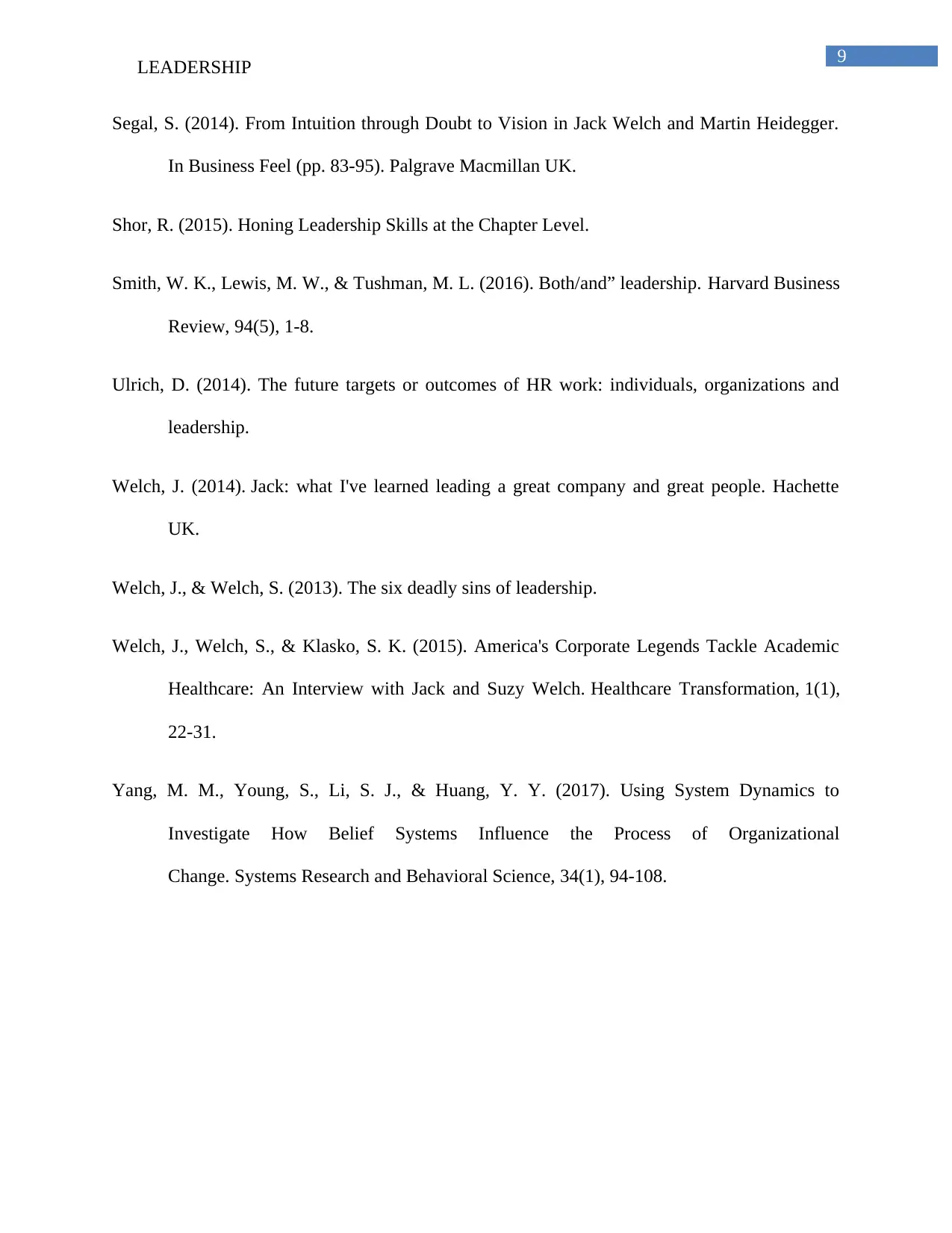
9
LEADERSHIP
Segal, S. (2014). From Intuition through Doubt to Vision in Jack Welch and Martin Heidegger.
In Business Feel (pp. 83-95). Palgrave Macmillan UK.
Shor, R. (2015). Honing Leadership Skills at the Chapter Level.
Smith, W. K., Lewis, M. W., & Tushman, M. L. (2016). Both/and” leadership. Harvard Business
Review, 94(5), 1-8.
Ulrich, D. (2014). The future targets or outcomes of HR work: individuals, organizations and
leadership.
Welch, J. (2014). Jack: what I've learned leading a great company and great people. Hachette
UK.
Welch, J., & Welch, S. (2013). The six deadly sins of leadership.
Welch, J., Welch, S., & Klasko, S. K. (2015). America's Corporate Legends Tackle Academic
Healthcare: An Interview with Jack and Suzy Welch. Healthcare Transformation, 1(1),
22-31.
Yang, M. M., Young, S., Li, S. J., & Huang, Y. Y. (2017). Using System Dynamics to
Investigate How Belief Systems Influence the Process of Organizational
Change. Systems Research and Behavioral Science, 34(1), 94-108.
LEADERSHIP
Segal, S. (2014). From Intuition through Doubt to Vision in Jack Welch and Martin Heidegger.
In Business Feel (pp. 83-95). Palgrave Macmillan UK.
Shor, R. (2015). Honing Leadership Skills at the Chapter Level.
Smith, W. K., Lewis, M. W., & Tushman, M. L. (2016). Both/and” leadership. Harvard Business
Review, 94(5), 1-8.
Ulrich, D. (2014). The future targets or outcomes of HR work: individuals, organizations and
leadership.
Welch, J. (2014). Jack: what I've learned leading a great company and great people. Hachette
UK.
Welch, J., & Welch, S. (2013). The six deadly sins of leadership.
Welch, J., Welch, S., & Klasko, S. K. (2015). America's Corporate Legends Tackle Academic
Healthcare: An Interview with Jack and Suzy Welch. Healthcare Transformation, 1(1),
22-31.
Yang, M. M., Young, S., Li, S. J., & Huang, Y. Y. (2017). Using System Dynamics to
Investigate How Belief Systems Influence the Process of Organizational
Change. Systems Research and Behavioral Science, 34(1), 94-108.
1 out of 10
Related Documents
Your All-in-One AI-Powered Toolkit for Academic Success.
+13062052269
info@desklib.com
Available 24*7 on WhatsApp / Email
![[object Object]](/_next/static/media/star-bottom.7253800d.svg)
Unlock your academic potential
© 2024 | Zucol Services PVT LTD | All rights reserved.




